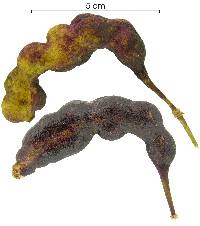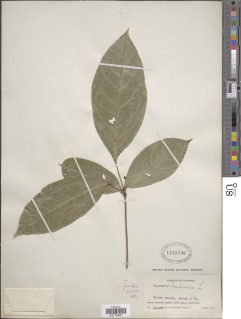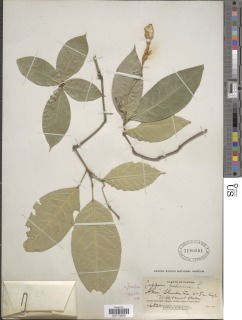

|
|
|
|
Family: Capparaceae
Churchblossom, more... (es: contra piedra, Garrotillo)
[Capparis frondosa Jacq.] |
Description: A shrub or small treelet of the forest understory, typically irregularly branched or with a leaning stem. Leaves are simple, alternate, and clustered toward the end of the branches. Petioles are highly variable in length, much shorter on upper leaves. Each petiole has a slight green swelling at each end, and the leaf is angled slightly from the petiole. Reproduction: Flowers are white, with elongated stigma resembling a spider's legs. These persist in the fruit. Flowers in January and February and again from July to September. The fruit is a pod, constricted between seeds, produced from November to May. Distribution: Widespread in forests near the Canal, from Pacific to Atlantic. Abundant in the shaded understory of the old-growth forest on Barro Colorado, but much less common elsewhere, although there are a couple patches of abundance near Gamboa and near Sherman. Not seen in open areas or along roads. Similar Species: The variable-length petioles are a very distinctive trait. One other species, LK dendar Dendropanax arboreus, LK2 has the trait, so the differences between the leaves need to be studied. Another Capparis in the area, LK capppi C. pittieri, LK2 is quite similar to C. frondosa, but it is only known from montane sites and the Santa Rita ridge, where frondosa does not occur. Descripción: Árbol o arbusto de 2 a 7 m de alto. Tronco con la corteza exterior negra y lenticelas blancas. Ramitas terminales cilíndricas. Hojas simples y alternas, de 6-20 x 3-10 cm, oblongas o elípticas, con ápice acuminado, bordes enteros y base redondeada o ligeramente cordada. Las hojas se encuentran agrupadas al final de las ramitas y son muy variables en tamaño. Pecíolo de 0.5-20 cm de largo y pulvinado en ambos extremos. Flores blancas con el receptáculo floral prolongado en un ginóforo, el cual persiste con el fruto. Frutos en silícuas alargadas, de 4-9 cm de largo y con constricciones entre las semillas, verdes, tornándose rojos y dehiscentes al madurar. Semillas envueltas por una pulpa blanca. Datos Ecológicos: La especie crece a bajas elevaciones, en bosques secos o húmedos. En Panamá se encuentra en las provincias de Coclé, Colón, Darién, Herrera, Los Santos, Panamá, Veraguas y la comarca de Guna Yala. Florece y fructifica de noviembre a febrero, y de julio a septiembre. Especies Parecidas: A menudo se confunde con LK cappdi Capparidastrum discolor LK2 , pero en C. discolor las hojas tienen el envés ligeramente blanco o gris y los frutos son globosos. Usos: La madera es empleada en la fabricación de mangos para herramientas y tajonas. Shrub or small tree, to 5 m tall. Leaves simple; petioles quite variable in length, very short or to 20 cm long (variable even on the same branch), pulvinate at both ends; blades oblong-lanceolate to oblong-oblanceolate, mostly acuminate, acute to obtuse at base, 4.5-22 cm long and 1.8-9 cm wide (variable in size even on the same branch); midrib raised above. Flowers in short racemes of few flowers in the upper leaf axils; pedicels 1-3 cm long (2-4 cm long in fruit); sepals 4, bluntly triangular, ca 1.5 mm long, open in bud, each with a minute disk gland at base within; petals 4, ovate, ca 1 cm long, obtuse at apex, white; stamens ca 100, 1.5 cm long; pistil oblong, ca 3 mm long, on a gynophore ca 1 cm long (ca 3 cm long in fruit). Fruits oblong, fleshy, tardily dehiscent siliques to 9 cm long, becoming maroon when mature, ca 1.5 cm wide, dehiscing irregularly lengthwise to expose seeds, the seeds ca 20, sticky, +/- spherical, ca 8 mm diam. Croat 5861, 7802. The species is distinguished by a combination of many-staminate flowers, petioles of greatly differing lengths, and purple siliques borne on a gynophore. |
|
|
|


































